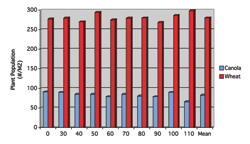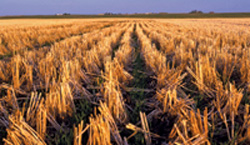
Features
Agronomy
Soybeans
Herbicide stacking residues are possible, but rare
What happens when residual Group 2 herbicides are applied two years in a row?
November 20, 2007 By Bruce Barker
The drought years of 2001 and 2002 combined to cause a 'perfect storm' for
herbicide carryover. When Group 2 herbicides were applied two years in a row,
some growers wondered if crop growth was not affected.
"Back when Everest was coming out in 2001, Bayer was doing field comparisons
with Everest and Horizon. The following year, peas were seeded on the field
and Odyssey was applied at the three to five node stage. About one week later,
the Everest side turned yellow, so the thinking was that the combination of
herbicides was causing the yellowing," says research assistant, Ken Sapsford
at the Crop Development Centre at the University of Saskatchewan. "But
I had some trials where Everest had been put on at varying rates, and then the
following year in field peas, Odyssey, Poast, or Sencor were applied. What it
showed was that Odyssey wasn't any worse than the others for yellowing of the
peas."
However, the feeling persisted that when two Group 2 herbicides with residual
characteristics were applied back to back in subsequent crops, carry-over could
hurt the crops. In response, the Saskatchewan Pulse Growers helped fund a comprehensive
research project in conjunction with Agriculture and Agri-Food Canada (AAFC)
and the University of Saskatchewan to look at the issue.
Eric Johnson, the lead researcher on the project from AAFC at Scott, outlines
the project. He says that stacking is defined as the repeated application of
different residual herbicides, which results in additive or synergistic phytotoxicity
to rotational crops. Surveys indicate that about 25 percent of prairie producers
use a soil residual Group 2 herbicide with 25 to 37 percent of them applied
in successive years.
 |

|
| 2004 wheat crop injury at 14 days after treatment at Scott. Check treatment (left) compared to Odyssey/Sundance (Odyssey in year one on peas and Sundance in year two on wheat), showing effect of herbicide stacking. Photo Courtesy of AAFC, Scott. |
|
The research study had two field experiments at eight locations in Alberta
and Saskatchewan to evaluate the repeated applications of Group 2 herbicides.
The objectives were to determine if a crop is predisposed to Group 2 injury
if a residual Group 2 herbicide was applied the previous year. In addition,
the researchers also wanted to determine if the repeated application of different
Group 2 herbicides in two successive years results in increased plant-back sensitivity
to susceptible crops grown in years three or four.
Wheat-field pea-cereal: No problem in pea; some barley
sensitivity
The first experiment involved a wheat-field pea-cereal (barley/wheat split)-canola
sequence. In this trial, Group 2 herbicides Assert, Refine Extra, Sundance,
Spectrum, Frontline and Everest were applied to the wheat in year one, along
with a Horizon (Group 1)+Buctril M tank-mix as a control group. In the year
two field pea crop, Basagran (Group 6), Sencor (Group 5) and Odyssey were applied
to the field peas. All herbicides were applied at label rates.
Johnson reports that in year two, the field pea year, there was little indication
that repeated application of Group 2 herbicides resulted in higher levels of
crop injury in field pea. "Field pea yields with stacked Group 2 herbicides
were not reduced," he says.
In the third year, comparing barley and wheat, a few sites showed sensitivity
to the stacked herbicides. Injury to barley from Sundance-Odyssey and Assert-Odyssey
sequences were reported at two sites (Scott and Vanscoy). Only one site (Vanscoy)
of seven had synergistic yield reductions in barley due to repeated Group 2
applications; the sequence of Assert-Odyssey and Sundance-Odyssey at Vanscoy
resulted in greater yield reductions than were predicted.
Synergistic injury and yield reductions were not evident in a rotational wheat
crop grown in this sequence.
Pea-wheat-canola: Some effects in wheat and canola
The second experiment was a pea-wheat-canola (Roundup Ready and Clearfield split)
sequence. In year one, Basagran (Group 6) and Odyssey were applied to field
pea. In the second year in wheat, Group 2 herbicides Assert, Everest, Sundance
and Frontline were applied, along with the Horizon+Buctril M tank-mix control
treatment.
In this experiment, Sapsford says that Odyssey applied in year one predisposed
wheat in year two to post-emergence Group 2 injury in two of 11 site years,
both at Scott, in years 2002 and 2003. Reduced yields occurred in only one of
11 site years.
"At the other sites, some of the wheat plots which had Odyssey treatments
the year before actually had higher yields," says Sapsford. "The carryover
didn't affect the wheat at any of the sites, except Scott."
The Scott site was characterized by low soil organic matter, low pH and low
summer precipitation when the experiments were conducted.
In the canola phase of the rotation, repeated residual Group 2 application
resulted in higher levels of crop injury in three of seven site years (Fairview,
Scott and Vanscoy). Synergistic yield reductions were reported in only two of
the seven site years (Scott and Vanscoy). Both of these sites received below
normal growing season precipitation during the years the experiment was conducted.
Saskatoon also received below normal precipitation; however, it is believed
the high clay content of the soil may have reduced the potential for herbicide
carryover.
Soil type and rainfall influence stacking carryover
While the majority of the sites did not experience stacking issues, Johnson
says that some impacts were observed at certain individual locations, albeit
infrequently. "It is pretty well limited to two or three products, Odyssey,
Sundance and Assert, in any sequence," he explains. "There is some
potential to stack under certain environmental situations and some soil types."
Johnson says those conditions tend to be when precipitation is low, on low
organic matter soils and, in the case of Scott, low pH as well. "Weather
overrides everything. The dry weather caused residue issues to show up at Scott
very early in the growing season because of the low organic matter content.
pH has some impact as well, and in general terms, low pH soil is also a risk,
particularly with the 'IMI' herbicides such as Odyssey and Assert."
| Soil characterization of sites for repeated Group 2 herbicide application studies. |
||||
| Site | Soil zone | Organic matter | pH | Texture |
| Scott | Dark Brown | 3.0 | 5.9 | Loam |
| Lethbridge | Dark Brown | 3.6 | 7.8 |
Clay loam |
| Saskatoon | Dark Brown | 3.8 | 7.4 | Clay |
| Vanscoy | Dark Brown | 5.3 | 7.1 | Loam |
| Fairview 1 | Gray | 6.0 | 6.3 |
Sandy loam |
| Fairview 2 | Gray | 7.1 | 6.1 |
Sandy clay loam |
| Vegreville | Black | 7.2 | 6.3 |
Clay loam |
| Melfort | Thin Black | 11.3 | 6.6 | Clay |
| Ellerslie | Black | 12.2 | 6.2 |
Silty clay loam |
| Source: Johnson, AAFC at Scott, Saskatchewan. | ||||
In areas that typically receive higher levels of growing season precipitation,
the risk of herbicide stacking appears to be low.
Johnson is now starting to look at stacking of Odyssey in field pea, followed
by Adrenalin in Clearfield wheat the following year. Adrenalin contains the
active ingredients imazamox (Group 2) and 2,4-D ester. Odyssey contains imazamox
and imazethapry (both Group 2). "We are looking at some of the soils that
showed higher potential for stacking to see if there is a concern."
Certainly based on the weather of 2005, with above average rainfall across
most of the prairies, the risk of herbicide stacking should be low in 2006.
The biggest caution for growers is when below average precipitation occurs on
soils with low organic and/or low pH. However, Johnson also says that applying
Group 2 herbicides back to back is not a recommended practice for managing herbicide
resistance. "Growers really shouldn't be doing that anyway. If a grower
follows reasonable herbicide rotations, this shouldn't be an issue." -30-